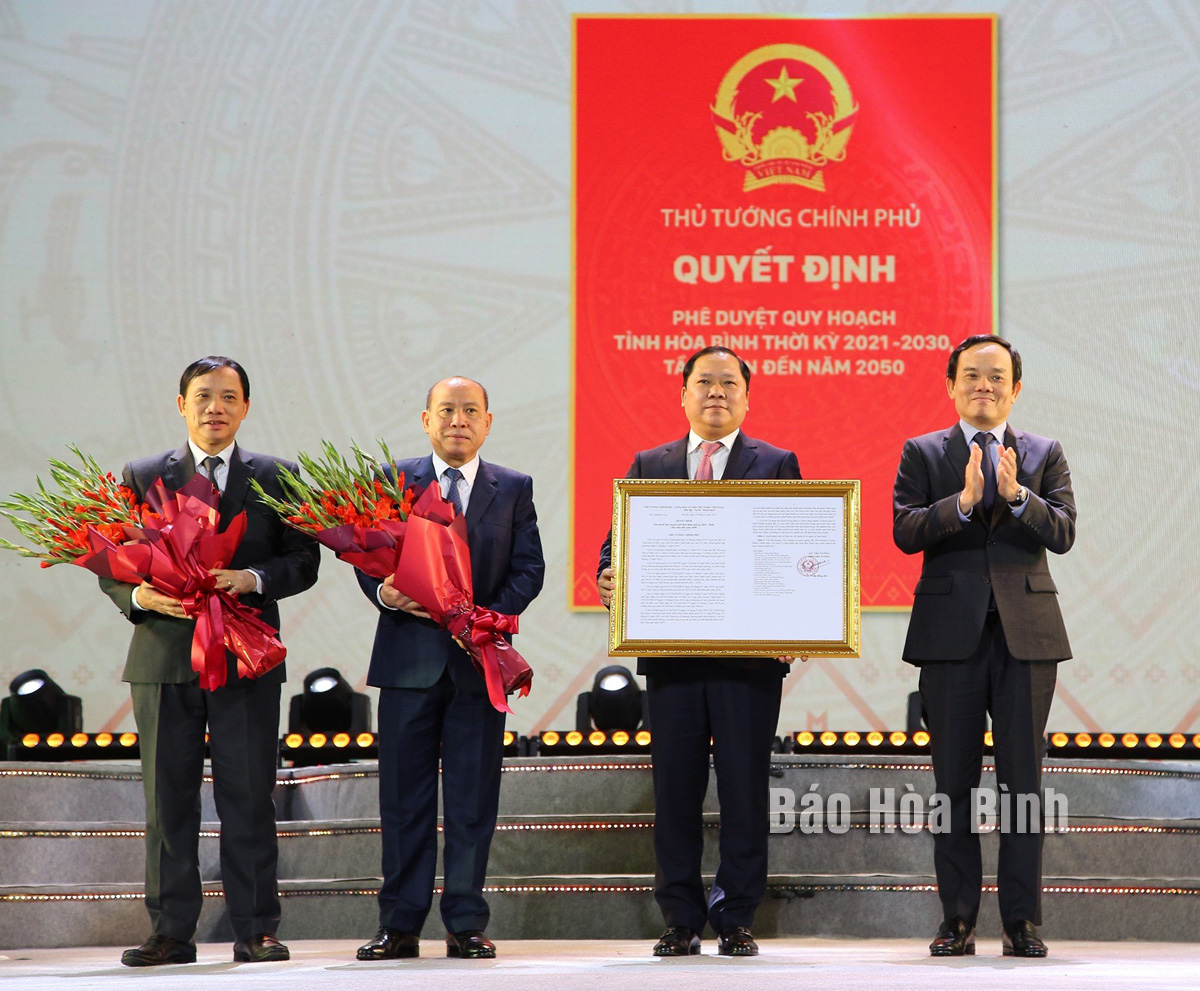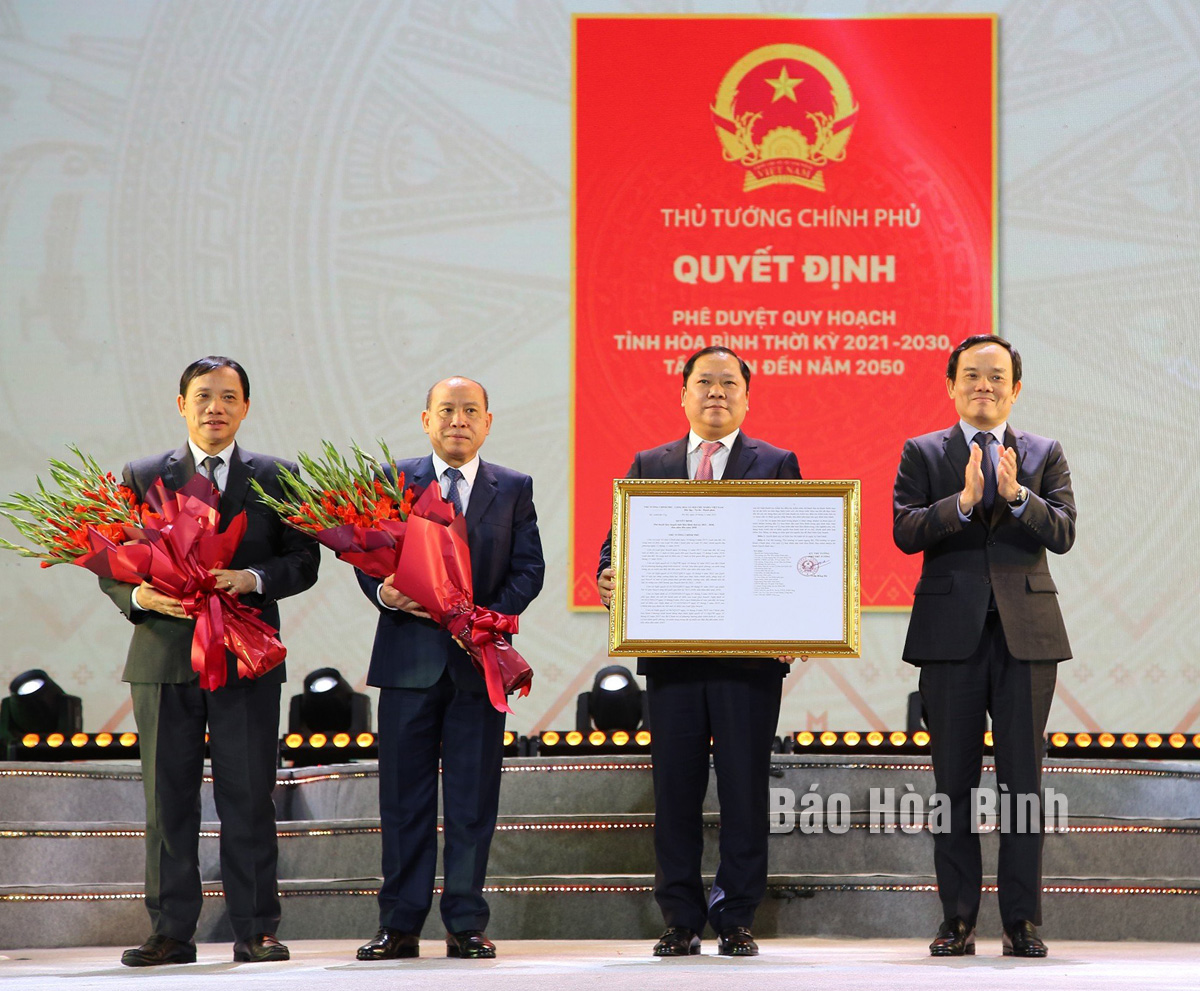
Ahead of the Lunar New Year, Hoa Binh received Decision No. 1648/QD-TTg, issued by the Prime Minister on December 20, 2023, that approves the Master Plan of the province for the 2021 - 2030 period, with a vision to 2050. With general targets and strategic breakthroughs identified, the Master Plan is like a comprehensive design reflecting a new mindset and vision and creating momentum for Hoa Binh to make development breakthroughs.
Deputy Prime Minister Tran Luu Quang
presents the decision approving the Hoa Binh Master Plan for the 2021 - 2030
period, with a vision to 2050, to provincial leaders.
Breakthrough
mindset, long-term vision
A conference announcing the Hoa Binh Master Plan
for the 2021 - 2030 period, with a vision to 2050, was held on January 22.
The Master Plan, detailing seven development
viewpoints, six focal tasks, five breakthrough steps, and four development
pillars, shows the targets, viewpoints, and general orientations of development
until 2030.
Accordingly, by 2030, Hoa Binh is set to have
reached a moderately good level of development, had its per capita income among
the highest in the northern midland and mountainous region, secured
high-quality human resources, completed digital transformation in all fields,
and recorded fairly good provincial competitiveness compared to others
nationwide. The local economy will develop with industry being the driver;
tourism a spearhead sector; mass-production, clean and organic agriculture the
foundation; comprehensive and modern infrastructure; along with a green and
smart system of urban areas. Meanwhile, natural resources and the environment
will be managed strictly and used efficiently, people’s material and spiritual
lives further improved, and cultural identities of ethnic groups preserved and promoted.
In addition, the province will actively integrate into the world, connect with
large economic hubs of Vietnam, and firmly ensure defence and security.
Addressing the conference, Nguyen Manh Lam,
Deputy Director of the Planning Investment Department under the Ministry of
Planning and Investment, said the Master Plan features many new points that can
bring into play local potential and advantages, including considering the
preservation and promotion of cultural values and the development of infrastructure,
especially road infrastructure, as one of the five breakthrough steps. It shows
a right orientation for Hoa Binh to maintain its role as a centre of regional
connectivity and realise its aspiration to move forwards.
The Master Plan will create many new
opportunities, impetuses, and projects for the province to develop in line with
the resolutions of the provincial Party Congress and the Party Central
Committee, Lam remarked.
"Compliance
- Flexibility - Consistency - Thorough understanding”
These are the keywords that Deputy PM Quang
asked Hoa Binh to pay attention to during the plan implementation.
He noted the most important thing of the Master
Plan is that it specifies the orientation and measures for achieving targets,
so compliance with the Master Plan is a must. Meanwhile, flexibility is needed
during the implementation so as to reach the set targets. The Master Plan must
be consistent with the plans of zones and sectors. Besides, leaders, those
directly implementing the Master Plan, and most importantly people need to
thoroughly understand it and engage in the building of plans for different
zones in the province to contribute to local development.
Part of Hoa Binh city nowadays.
Nguyen Phi Long, alternate member of the Party
Central Committee and Secretary of the provincial Party Committee, said Hoa
Binh will quickly build an implementation plan to submit it to the PM for
approval. The implementation plan will identify focal tasks and measures,
roadmap, progress, and resources for carrying out the Master Plan.
He affirmed that with solidarity, joint efforts,
unanimity, dynamism, creativity, and aspiration for development, the Party
organisation, administration, and people of all ethnic groups in Hoa Binh are
determined to successfully fulfill the tasks and targets set in the Master
Plan.
Hoa Binh province is undergoing a dynamic transformation amid Vietnam’s national digital transition. Building on Poliburo’s Resolution No. 57-NQ/TW on breakthroughs in science, technology, innovation, and national digital transformation, the province has rolled out a wide range of practical action plans. A standout initiative is the "Digital Literacy for All” movement, an effort to ensure that no one is left behind in the digital era.
Hoa Binh province is undergoing a dynamic transformation in the wake of the national digital transformation movement. Building on Resolution No. 57-NQ/TW of the Politburo on breakthroughs in science, technology, innovation, and national digital transformation, the province has implemented a wide range of practical action plans. A standout initiative is the "Digital Literacy for All” movement ambitious effort to ensure that no one is left behind in the digital age.
With a spirit of unity and proactive problem-solving, the Party Committee, the government and the people of Dong Lai Commune (Tan Lac District) have made great strides in implementing the resolutions of the 24th Party Congress of the commune for the 2020 - 2025 term. Focusing on leadership and practical actions, the commune has brought the Party’s resolutions into daily life, creating strong impacts and pushing the local development forward.
Amid the nationwide push for digital transformation, young people in Hoa Binh Province are stepping up as dynamic pioneers, applying technology to enhance Youth Union operations and expand the reach of youth-led initiatives. Through creativity and adaptability, Youth Union organizations at all levels have introduced a series of practical solutions, contributing to modern governance and community development.
In recent years, An Nghia commune, located in Lac Son district, has stepped up administrative reform, focusing on improving the quality and efficiency of its single-window service unit for receiving and processing administrative procedures. These improvements have helped create favourable conditions for local residents and organisations to handle administrative procedures, contributing to the commune’s broader socio-economic development.
The Prime Minister-approved master plan to develop the multi-use value of forests ecosystems through 2030, with a vision to 2050, aims to improve the management and sustainable use of forest resources, create jobs, increase incomes, and improve the living standards of ethnic minorities, people in mountainous and remote areas, forest workers and those living near forests.




